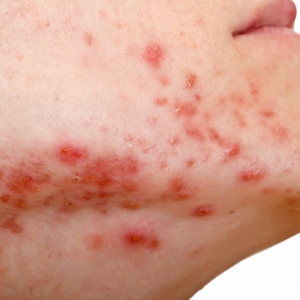
Dr. Kevin McKerrow
DERMATOLOGIST
+ SEE BIO
Scars that remain after acne treatment can be either depressed or raised. These present in three main types – boxcar, icepick, rolling and combinations of the three. Rolling scars are those which are like broad, low hills. Boxcar scars have a thick, hard centre which is often white, that pulls down in the centre. Icepick scars are very narrow and deep. These are all depressed (atrophic) scars, meaning there is an overall loss of skin. Most acne scar treatments attempt to either remove or replace abnormal tissue and to stimulate new collagen formation to fill in the old scars. Raised acne scars can be either hypertrophic scars or keloids.
Brown marks or red marks persisting on the skin where acne has occurred and where the acne has now cleared is a most common complaint amongst acne patients. Many patients feel these red or brown marks make their skin appear more broken-out and uneven than it truly is. Treatments are available to help lighten and remove these old acne marks. The Genesis procedure is a gentle, painless and no down-time laser treatment which can speed up the process of reducing the red and brown marks.
Choosing a specialist dermatological facility for acne scar removal provides more choices for treatments, ways to control future outbreaks and complementary cosmetic procedures to restore your skin’s appearance. Acne usually leaves some scarring, although it is often minimal and most people experience acne outbreaks in the course of their lives. Acne is most common during adolescence, but acne can occur at any time and adult acne often erupts more severely, producing disfiguring scars. As the acne lesions heal, the various shapes and sizes of scars remain as a permanent reminder of this common facial eruption. Acne scars make many people feel embarrassed or self-conscious. Fortunately, acne scar treatment can remove or minimize them through cosmetic treatments. Treatment options depend on the severity of the scarring and the type of acne scar.
Permanent textural changes and indentations that occur on the skin following severe acne result in acne scars. Scarring occurs as the body creates collagen to repair the damage. Depending on the skin type and other factors, the scarring can be relatively shallow and easy to correct, or deep where scarring is more severe. The healing process creates significant changes in the texture and smoothness of the skin, forming depressions (lost tissue) or giving the skin a rolling, wave-like appearance (adds tissue).
Acne is an inflammatory process. In the non-inflammatory phase (when there are only comedones), there is no scarring. Once the non-inflammatory lesion evolves into an inflammatory lesion, the mechanisms of wound healing are activated. If the inflammation is extensive and deep extending into the deep dermis and continues untreated, scarring results. The different types of acne scars are as a result of the extent, depth and degree of inflammation that is followed by repair. On the face, commonly there is an indentation (depressed scar), and on the chest and the back the scarring can be raised and lumpy – known as hypertrophic or keloid scarring.
On the face, acne scarring appears as damage to the skin texture with indented areas of various sizes. On the chest and back, scars tend to be raised and lumpy. The following are the main types of acne scars:
Boxcar Scars: Boxcar scars are punched-out scars with vertical, sharp edges which may be shallow or deep. They are most commonly located on the cheeks and temples. Shallow scars are treated with subcision, followed by either full laser resurfacing (ablative CO2 – Smart Xide Dot laser), fractional lasers (ablative CO2 or ablative Erbium – Smart Xide Dot laser, Fraxel Restore Dual), dermal fillers and radio-frequency treatments (e-Two Sublative). Deep scars can be treated with punch excision, followed by resurfacing (to remove the surface layer of the skin and promote new skin cell production).
Icepick Scars: Icepick scars are deep, narrow, sharply defined tracts, extending vertically to the deep dermis or the subcutaneous tissue, creating an appearance that the skin has been punctured with an icepick. The surface opening is wider than the deeper portion as it tapers into a vee and gives the appearance of open pores and tend to worsen with age, as the skin becomes lax. They are more commonly seen on the cheeks, between the eyebrows and the nose. Due to the depth of ice-pick scars, fractional treatments are not as effective as TCA cross (i.e. trichloroacetic acid chemical reconstruction of skin scars). Punch excision and laser resurfacing are supplementary procedures to enhance results.
Rolling Scars: Rolling scars appear as undulations and depressions on the skin (create a wave-like pattern). They are shallow, atrophic scars that are caused by tethering of the underlying dermis to the subcutaneous tissue by fibrous bands. They are wide scars, with relatively normal appearing skin. The clue to these types of scars is that these scars will get effaced and appear normal if the skin is stretched. Among the various types of acne scars, they are relatively easier to treat. Methods of treatment include subcision, fractional laser resurfacing (Fraxel Restore Dual), radio-frequency (e-Two Sublative) and dermal fillers (hyaluronic acid). Acne scarring of this sort usually requires several treatments for the best possible outcome.
Mixed Acne Scars: The most common form of acne scarring is a mixture of the above, hence numerous treatment modalities will be required for improvement and a tailored approach to scar revision is necessary to provide the best outcome.
Red Acne Scars & Macular Scars: Flat erythematous acne scars are commonly seen on the cheeks and forehead areas and occur as a result of early acne scarring. Generally this type of scarring can fade over 6 – 12 months without treatment. Vascular laser treatment (Candela VBeam Perfecta laser and Excel V) will hasten the resolution of scars and several treatments are usually required for an optimal result.
Brown Scars: Darker (especially those with type IV – VI) skin types have a tendency to develop pigmentation in areas of inflamed skin. It can be transient, but if it persists treatment can be considered with the Q-switched Yag laser (Revlite) or with bleaching creams such as varying concentrations of Hydroquinone.
Hypertrophic & Keloid Scars: Hypertrophic and keloid scars are more common if poor surgical technique is initially performed. To reduce the incidence of these scars it is essential that wounds be orientated correctly at the time of surgical removal of a lesion, that tension is reduced and special non-reactive sutures are placed within the wound. Keloids can be caused by acne, body piercings, surgery, tattoos or any injury or inflammation of the skin. Keloids are much more common on the chest, shoulders, upper back, arms and ear lobes and also tend to itch and be painful. A combination of treatments produce the overall best result, including silicone sheeting applied to the scar, injections of intralesional steroid/Five Fluorouracil, pulse dye laser treatments (Candela VBeam Perfecta) and fractionated CO2 (Smart Xide Dot laser).
There are numerous treatments available for acne scars which can improve and soften the appearance of scarring. Given the complexity of acne scars, a combination of treatments is required. The treatment approach will depend on four factors:
Hyaluronic acid fillers are best suited for shallow, broad-based acne scars and have the advantage of immediate improvement and minimal downtime. Treatment is usually repeated at six monthly intervals.
Intralesional corticosteroids/Five Fluorouracil injections are best suited for thick, lumpy scars. Usually several injection treatments are needed and the treatment can be combined with vascular laser at the same time.
There are two main types of laser treatments – ablative and non-ablative. With ablative lasers there is removal of thin layers of skin, and with non-ablative lasers (non-wounding) there is stimulation of collagen growth and tightening of the underlying skin.
Fully ablative CO2 lasers are best used on lighter skin types, whereas fractional CO2/Erbium lasers have a much higher safety profile than fully ablative lasers and can be used on all skin types. The downside of ablative lasers is the longer recovery time which can be up to three weeks, with redness being the most common temporary side-effect.
Fractional (non-ablative) lasers are of variable wavelengths and improve acne scarring, especially in atrophic and rolling scars. They are also associated with temporary redness but there is no breakage of the skin surface. They have the advantage of rapid recovery times and the ability to treat darker skin types, with a higher safety profile. Recovery time is between 5 – 10 days. Most individuals will benefit from a series of fractional treatments but five treatments are usually required. Vascular lasers such as pulse dye lasers (Candela VBeam Perfecta) and Excel V can be used to treat the early red scars known as macular acne scars.
This is a non-invasive method of scar remodelling and is best employed in early acne scars, atrophic scars, rolling scars and is ideal in treating darker skin types, having the benefit of minimal chance of post-inflammatory hyperpigmentation. The eMatrix system (e-Two Sublative) is a unique sublative treatment which delivers a fractionated bi-polar radiofrequency technology that is highly effective for improving acne scars. This treatment is safe and effective on all skin types. The radiofrequency energy delivers fractional bulk heat deep into the dermal layer, to induce a skin injury in the region of the electrode handpiece. The skin surface and the surrounding tissue are not damaged, resulting in an accelerated healing process while maximising collagen production. The sublative treatment impacts only 5% of the top layer of skin (the epidermis). Therefore most of the dermis (the deep layer of skin) is affected, giving each individual optimal results with a quicker healing response and minimal downtime.
TCA Cross (trichloroacetic acid chemical reconstruction of skin scars) is a method which uses high strength trichloroacetic acid, with strengths varying between 50 – 100% and is ideal for icepick scars. Usually two to three treatments are required.
Such procedures include punch excision, punch elevation and subcision, which are useful for deep icepick scars, as well as tethered scars. Usually such approaches are followed by laser resurfacing or radio-frequency.
Subcision is an excellent treatment for rolling or boxcar-type acne scars, which often have fibrous attachments holding the base of the scar down to the underlying deeper tissue. After the surrounding skin is anaesthetised, a small needle is carefully inserted under the skin to sever and release these attachments beneath the scar. During the healing process, collagen remodelling occurs and new collagen is laid down beneath the scar, further improving the smoothness of the skin. Occasionally a filler substance (hyaluronic acid) can also be injected under the scars after subcision, to make the scar look less visible and to produce further enhancement.